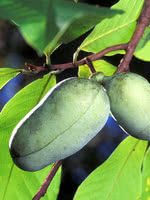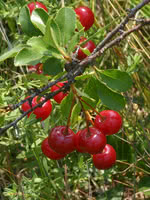Mon-Fri 9am - 5pm Mountain time
Pawpaw vs Cutie Pie Sour Cherry
Asimina triloba
Prunus cerasus Cutie Pie
NOT AVAILABLE THIS SEASON - MIGHT RETURN
The Pawpaw tree produces delicious, sweet fruit with a unique banana-mango flavor. These oblong fruits start yellowish-green and mature to a dark brown in the fall. It is best to leave them on the tree until ripe, as they do not ripen well once picked. Pawpaws can be enjoyed fresh, in baking, or in ice cream.
Pawpaws produce the largest native fruit in North America. They typically grow as a small understory tree or large shrub on wooded slopes, in ravines, and along stream banks. They often spread through root suckers, forming dense thickets over time.
For fruit production to occur more than one genetically different Pawpaw tree is required. Our Pawpaw seedlings are grown from seed so they are all genetically different.
Note: Avoid eating the seeds and skin of the Pawpaw fruit as they can cause stomach pain for some individuals. Contact with the skin of the fruit can also result in skin irritation, so it is recommended to wear gloves during harvest. Plant this tree once. Due to its large tap root transplanting is not recommended.
The Cutie Pie Sour Cherry produces fruit that are sweeter than other sour cherry varieties. Good for fresh eating and for making jams and jellies. They are small in stature (shrub like) and multi stemmed, which makes for a good hedge.
They are cold hardy and are a hybrid of Mongolian and European sour cherries, produced by the University of Saskatchewan.
They have small, attractive, white flowers. Cutie Pie Sour Cherry trees are self pollinating and require moist, well-drained soil. For better yields, plant compatible cultivars such as the Romeo Cherry nearby.

